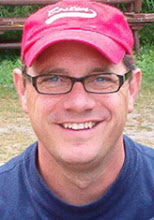 A Duke physicist is helping sort out a scientific mystery in the debris of some high energy subatomic particle smashups at the Fermi National Accelerator Laboratory. An unexpectedly large number of muons are appearing in ways that can't be explained by known physics.
A Duke physicist is helping sort out a scientific mystery in the debris of some high energy subatomic particle smashups at the Fermi National Accelerator Laboratory. An unexpectedly large number of muons are appearing in ways that can't be explained by known physics.The excess muons, which are heavier versions of electrons, could be evidence for some form of mysterious dark matter, acknowledges associate physics professor Mark Kruse.
They could even be decay products connected to the Higgs boson, the so-called "God particle" which is being sought at Fermilab, the world's most powerful particle collider, and its even more powerful successor in Europe, the Large Hadron Collider (LHC) at CERN.
Kruse, who co-leads of Higgs investigations at Fermilab's CDF detector group and will also work at CERN, suspects the anomaly will probably turn out to be nothing special. But "I think it's exciting either way," he says. "It's sort of a warning that we should be prepared for new physics to show up in ways that we're not necessarily expecting."
 Fermilab and the LHC are both designed to smash subatomic protons together at energies high enough to create particles that no longer exist or have not been identified in today's universe. The Higgs, for instance, is supposed to instill mass in matter but only shows up today as an undetectable force field.
Fermilab and the LHC are both designed to smash subatomic protons together at energies high enough to create particles that no longer exist or have not been identified in today's universe. The Higgs, for instance, is supposed to instill mass in matter but only shows up today as an undetectable force field.Another goal is to confirm or overrule the tenants of the Standard Model of elementary particles and forces, which was devised by the world's physics community and so far remains unchallenged.
Under the Standard Model, muons can be among the decay products of b quarks and antiquarks produced when protons and antiprotons collide at Fermilab. But twice the expected numbers have been found to originate outside the collision region in the CDF detector.
"Fifty percent can be explained by known processes, but there's still a huge number than can't," Kruse says. "We're talking about tens of thousands of events." And some of those muons are also being produced as multiple groups. "There's nothing in the Standard Model that can explain that," he adds.
A list of scientists almost four pages long signed onto the 68 page scientific report describing the "multi-muon events" at Fermilab. But another third of the CDF collaboration declined to add their names. "They thought more crosschecks had to be done," Kruse says.
He says he helped "shepherd" the completion of that study http://arxiv.org/PS_cache/arxiv/pdf/0810/0810.5357v2.pdf , and was involved in another shorter one http://arxiv.org/pdf/0810.5730v1 speculating on the possible implications.





